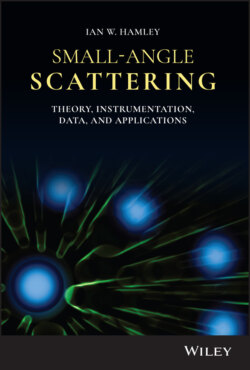Читать книгу Small-Angle Scattering - Ian W. Hamley - Страница 23
1.6.6 Microemulsions
ОглавлениеA widely used expression for the scattering from bicontinuous microemulsions is due to Teubner and Strey. The intensity is computed from a phenomenological Landau–Ginzburg free energy expansion including gradient terms of the composition order parameter. The structure factor (as in the previous section written as an intensity) is given by [43, 44]:
(1.66)
The terms a2, c1, c2 are coefficients in the free energy expansion and for a microemulsion, c1 < 0 while a2 > 0 and c2 > 0. The term 〈η2〉 = ϕ1ϕ2(Δρ)2 represents a weighted difference in scattering densities between the two phases with volume fractions ϕ1 and ϕ2. The corresponding real‐space correlation function related to Eq. (1.66) by a Fourier transform is
(1.67)
Here k = 2π/d. There are two length scales associated with the microemulsion, the correlation length given by
(1.68)
and the domain size given by
(1.69)
Figure 1.14 shows an example of fitting SAXS data for a microemulsion using the Teubner‐Strey structure factor. The intensity at high q in the Teubner‐Strey equation shows limiting Porod behaviour:
(1.70)
Figure 1.14 Example of SAXS data for a bicontinuous microemulsion (Pluronic copolymer with tannic acid in aqueous solution) (open symbols), fitted to the Teubner‐Strey structure factor (red line).
Source: From Dehsorkhi et al. [45]. © 2011, Royal Society of Chemistry.
Berk gave an alternative (more complex) expression for Γ(r) for a random wave model, which can also be used to describe bicontinuous microemulsions [46].
For a two‐phase system with a preferred correlation length, the Debye‐Bueche structure factor, sometimes known as the Debye‐Anderson‐Brumberger model [47–49] may be used:
(1.71)
In this model, the correlation function exhibits a simple exponential decay:
(1.72)
Here again, ξ is a correlation length. Comparison of Eqs. (1.72) and (1.67) shows that the Teubner‐Strey equation introduces the damped periodic function j0(kr) = sin(kr)/kr into the correlation function. Figure 1.15 shows examples of calculated intensity profiles with the Debye‐Bueche structure factor. The Debye‐Bueche model is obtained as a special case of the Teubner‐Strey model for very large d‐spacing (d ≫ ξ). The intensity decays as q−4 in the Porod regime at high q [48].
Figure 1.15 Calculated structure factors using the Debye‐Bueche structure factor with I(0) = 0 and the correlation lengths indicated.
Other types of microemulsion contain droplets, and the scattering can be described using models for the form and structure factors of globular objects.
